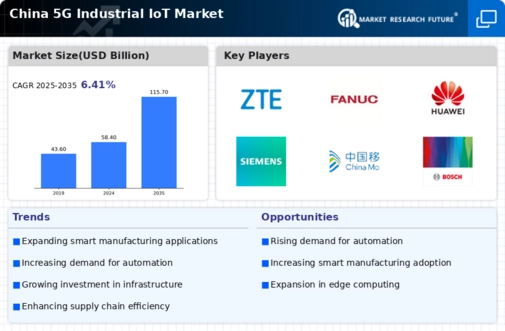Enhanced Connectivity Solutions
The 5G Industrial-IoT Market in China is experiencing a surge in demand for enhanced connectivity solutions. With the advent of 5G technology, industries are witnessing unprecedented data transfer speeds and reduced latency, which are crucial for real-time applications. This connectivity enables seamless communication between devices, facilitating the implementation of smart factories and automated processes. According to recent estimates, the deployment of 5G networks is expected to cover over 90% of urban areas in China by 2025, significantly boosting the operational efficiency of various sectors. As industries increasingly rely on interconnected devices, the need for robust connectivity solutions becomes paramount, driving growth in the 5g industrial-iot market.
Focus on Cybersecurity Measures
As the 5G Industrial-IoT Market expands, the focus on cybersecurity measures is becoming increasingly critical. The interconnected nature of IoT devices exposes industries to potential cyber threats, necessitating robust security protocols. Companies are investing in advanced cybersecurity solutions to protect sensitive data and ensure the integrity of their operations. The Chinese government has recognized this challenge and is implementing regulations to enhance cybersecurity standards across industries. With the anticipated growth of the IoT sector, the cybersecurity market is projected to grow at a CAGR of around 20% through 2025. This emphasis on security is likely to drive investments in the 5g industrial-iot market, as organizations seek to safeguard their digital infrastructure.
Government Initiatives and Support
The Chinese government plays a pivotal role in the growth of the 5G Industrial-IoT Market through various initiatives and support programs. Policies aimed at promoting technological innovation and infrastructure development are being implemented, with substantial investments allocated to 5G network expansion. The government has set ambitious targets, including the establishment of over 600,000 5G base stations by 2025, which is likely to enhance the industrial landscape. Furthermore, subsidies and incentives for companies adopting 5G technologies are fostering a conducive environment for innovation. This proactive governmental approach is expected to catalyze advancements in the 5g industrial-iot market, encouraging industries to transition towards more connected and efficient operations.
Integration of AI and Machine Learning
The integration of artificial intelligence (AI) and machine learning (ML) technologies within the 5G Industrial-IoT Market is emerging as a key driver of innovation. These technologies enable predictive maintenance, quality control, and enhanced automation, which are essential for modern manufacturing processes. The ability to analyze data generated by IoT devices in real-time allows for smarter decision-making and improved operational efficiency. In China, the AI market is expected to reach approximately $30 billion by 2025, indicating a strong alignment with the growth of the 5g industrial-iot market. As industries increasingly adopt AI and ML solutions, the synergy between these technologies and 5G connectivity is likely to foster significant advancements in industrial operations.
Rising Demand for Real-Time Data Analytics
In the context of the 5G Industrial-IoT Market, there is a notable increase in the demand for real-time data analytics. Industries are recognizing the value of data-driven decision-making, which is facilitated by the high-speed connectivity offered by 5G. This technology allows for the collection and analysis of vast amounts of data in real-time, enabling companies to optimize operations, reduce downtime, and enhance productivity. Reports indicate that the market for data analytics in industrial applications is projected to grow at a CAGR of over 25% through 2026. As organizations strive for operational excellence, the integration of real-time analytics into their processes is likely to propel the growth of the 5g industrial-iot market.





















Leave a Comment